On your bike: How Cork, Limerick and Waterford are playing catch-up for cycling commuters
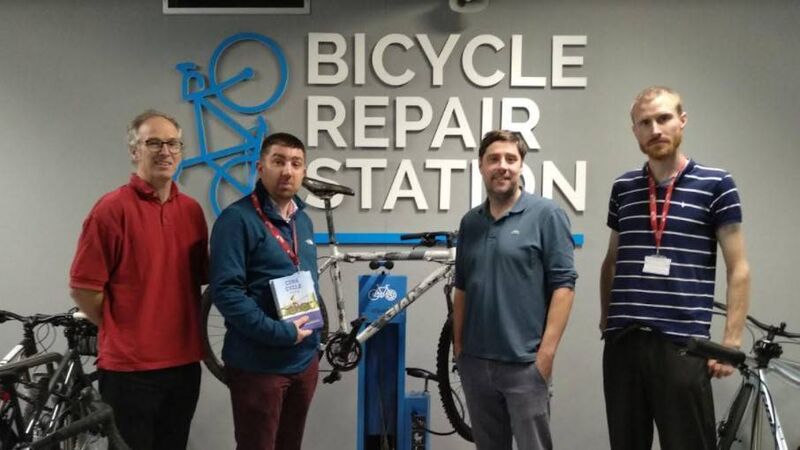
Cork Cycling Campaign giving a workshop in JCI at the newly installed bike repair station. Picture: David O'Leary
Ireland used to be a cycling country.
In the 1930s, bicycles were all the rage in Ireland, dramatically changing the social lives of ordinary people in every parish in the country, and becoming one of the primary modes of transport. The National Museum of Ireland even has an exhibition dedicated to cycling.
But cycling culture waned with the rise of the motor car. Having grown up after the turn of the millennium, cycling was something I only did in loops around the garden, after my parents were sure to shut off the gate to the busy main road over the hedge. I got the bus and later drove to secondary school. Until I got older and found myself having to cross Cork city on the college commute, the thought that cycling could actually be used to get anywhere was a pretty foreign concept.
In the words of Paul Rouse writing for this paper in 2016, “the bicycle became increasingly considered by many to be the preserve of the child, the student, the poor, or the hopelessly eccentric”.
Even amongst those groups, the downward trend in commuter cycling in the past 35 years is directly correlated with a dramatic upsurge in the number of people driving to work, college, and even secondary school.
Almost two-thirds of journeys in Cork city are made by car, according to the city’s latest draft development plan. Only 1% of journeys are made by bike.
There’s approximately 100km of cycling infrastructure in the city’s metropolitan area, but according to the 2040 transport strategy, the present cycle network is “disjointed and of variable quality”, particularly outside the immediate City Centre.
The Cork City Bike-sharing scheme, launched in 2014, has 330 bikes located at 32 bike stations. From 2015-2019, the scheme saw a steady decline in yearly customer trips, from 279,882 in 2015 to 241,064 in 2019, but numbers dropped drastically during the pandemic, with only 54,454 trips made in 2021.
In 2020, the NTA attributed the decline in the number of journeys made on the bike rental schemes in regional cities to changes in bus services and timetables, while users have reported poor maintenance of bikes and docking stations as the main reason for their reduced popularity.
The transport strategy sees the potential for mode share to increase to 4% by 2040, while the City Council’s Draft Development Plan aims to reach 4% of journeys by bike by 2028. However, Cork Cycling Campaign is a lot more ambitious, suggesting that a target mode share of between 13% and 20% is achievable in Cork by 2028.
Cork City Council has recently been funded by the NTA to hire up to 23 people for a new active travel team, to help fast-track the delivery of cycling and walking facilities, as well as to support the Bus Connects Programme. The first six positions are currently being filled.
As part of the ‘Re-Imagining Cork City’ pandemic rejuvenation project, €2m was announced for investment in the city’s cycling infrastructure, including over 4km of new cycle lanes, the resurfacing of 6km of cycle lanes and bus corridors, upgrading 4km of cycle lanes with the installation of light segregation, and 43 new bike parking bays to cater for 500 bikes. Cork City Council did not respond to a request for information as to how much of this has been spent.
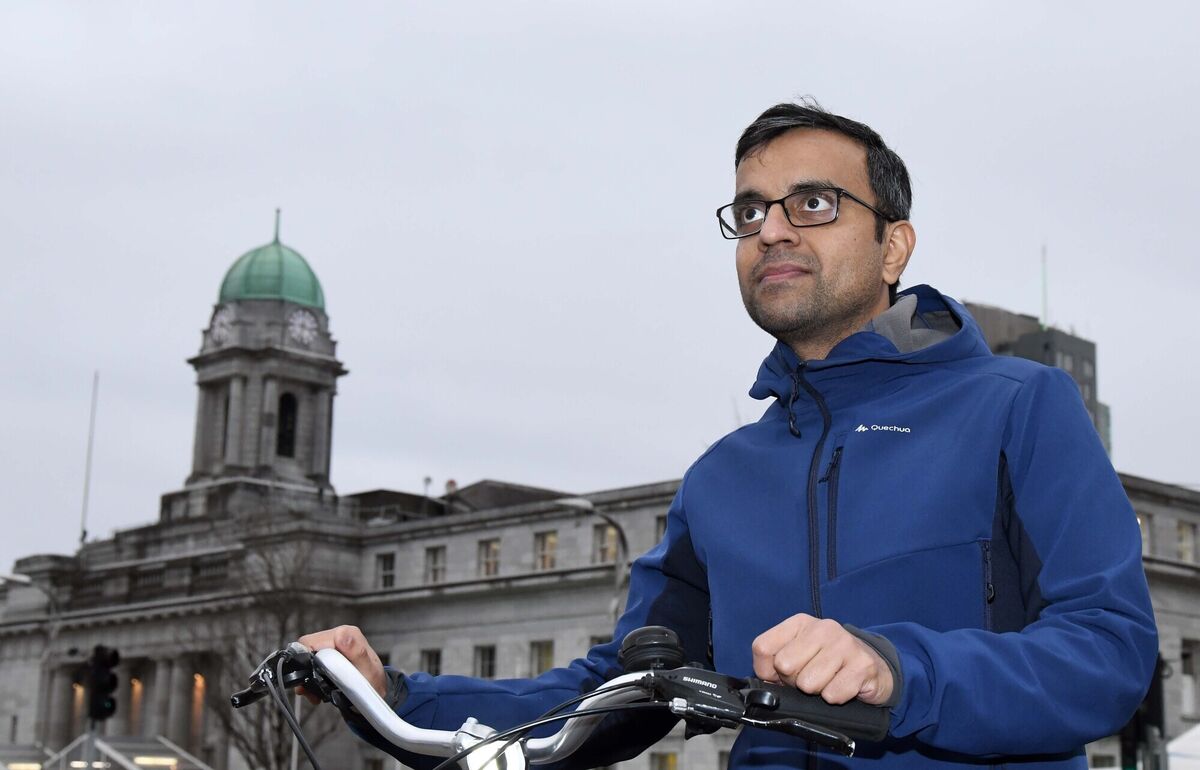
Prasanna Ramaswamy is a member of Cork Cycling Campaign, and said that the cycling terrain in Cork has come on leaps and bounds in recent years, particularly since this pandemic project. However, he said the focus needs to shift from piece-meal cycle lanes to continuous cycle routes.
“What tends to happen is that many times at the junctions for cycling infrastructure projects, the cycle track just disappears and merges into a shared pedestrian and cycle area. This creates a lot of conflict with pedestrians, and it's confusing,” he said.
Fellow cyclist Brendan Murphy agrees. He has no direct cycling route into the city from the East apart from a 100km/hr dual carriageway with no hard shoulder.
“If you try to map the city cycle lanes out, you can see these massive gaps where you just can't get from one side to the other. Putting in direct routes from each of the suburbs would be a game-changer quite frankly,” he said.
“If you could just get a councillor from the city, and say, right, do your commute on a bike? And if they say no, I can't, you go, right, neither can I, and that is the problem,” he added.
Mr Ramaswamy said the planned Lee to Sea Greenway will be key to encouraging leisure, tourist and commuter cycling. The planned Greenway will be a walking, running, and cycling route from Inniscarra Dam, following the River Lee through the city centre via the quays before travelling along the western shore of Cork harbour, ending at Crosshaven. Cork City Council’s Draft Development Plan includes a commitment to work towards delivering the Lee to Sea by 2028.
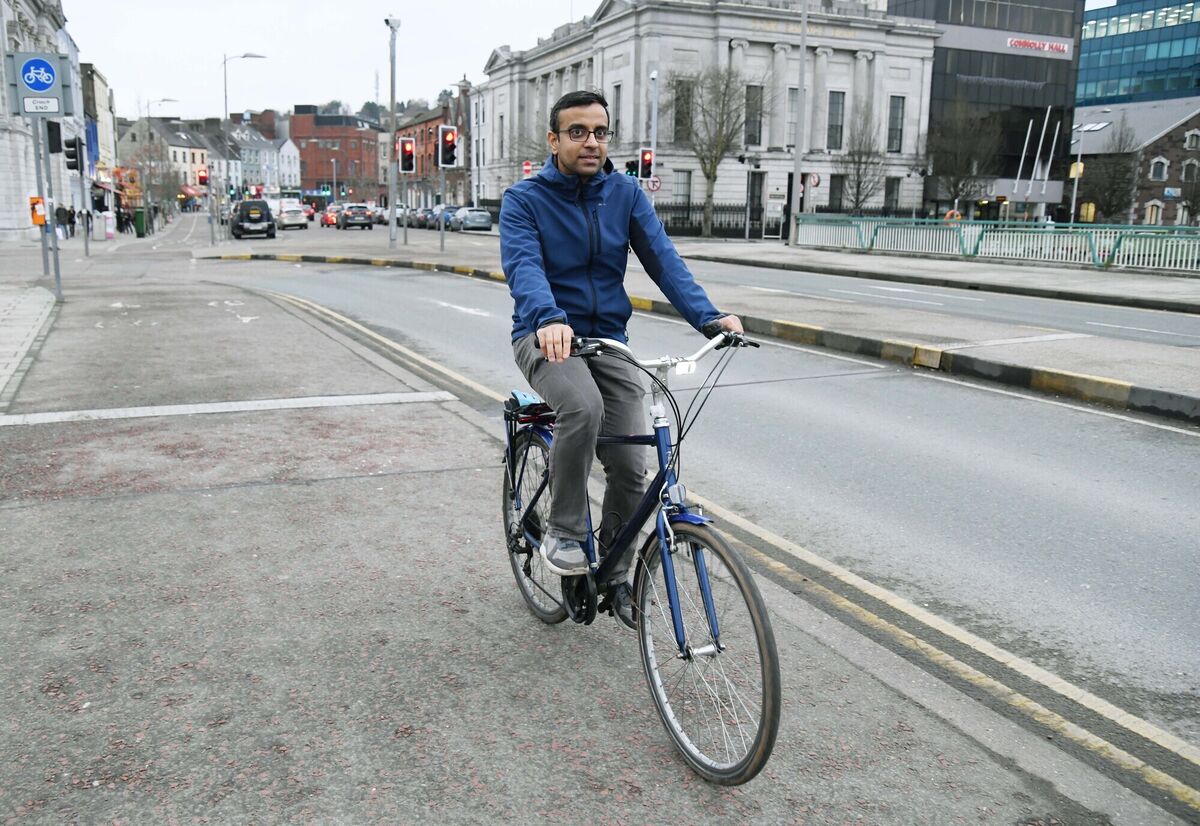
“The Lee to Sea is one of the big projects that we have been campaigning for a long time. It already exists in many pieces throughout the Cork Metropolitan Area, it’s now just a matter of connecting all of these up,” he added.
In 1986, the census recorded more than 60,000 people pedalling to work and school every day — 6.7% of the commuting population. 5.6% of people cycled to work, 4.2% of children to primary school, 14.9% of teenagers to secondary school, and almost a quarter of students (24.9%) to college.
Driving was already dominant among workers, with 37.1% of people driving themselves to work, while a negligible 0.1% of teenagers drove themselves to secondary school, and only 4% of students drove themselves to college.
By 2016, the proportion of people travelling by bike was down to about a third of the 1986 figure, at just 2.6% (a slight increase on the all-time low of 2.1% in 2011). Only 2.8% of people cycled to work, with just 1.3% of children cycling to primary school, 2% of teenagers cycling to secondary school, and 5.5% of third-level students travelling by bike.
In Limerick, while progress in delivering on infrastructure has been slow thus far, the city has a newly formed Active Travel team.
Like in other regional cities, there is a legacy of car dependency in Limerick. The NTA’s Draft Limerick/Shannon Metropolitan Area Transport Strategy 2040 shows that the modal share of car journeys in Limerick is 61%, with only 2% of journeys by bike.
The city’s bike-share scheme, introduced in 2014, has 23 stations and 215 bikes across the city centre. As in Cork, use of the shared bikes fell year on year, from a peak of 39,009 trips in 2015 to 22,129 in 2019, with only 4,865 trips in 2021 due to the pandemic.
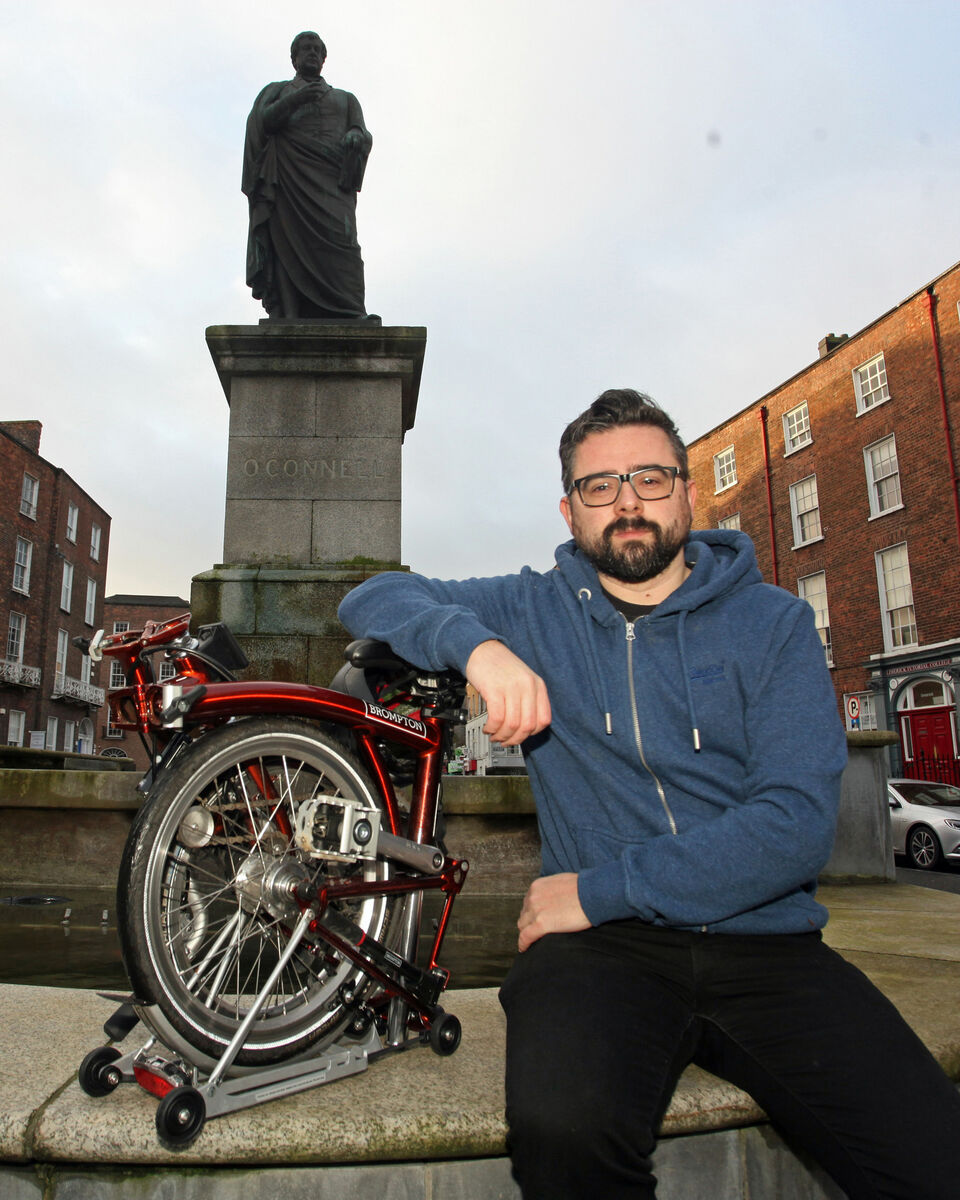
Dave Tobin is an executive member of the Limerick Cycling Campaign. Up until recently, he had been disappointed with the slow progress of cycling infrastructure in Limerick City.
“The Limerick Metropolitan Cycle Network study was undertaken in 2014 with a finish date of a full cycle network by 2020. We have seen at most 10% of that network achieved in that time,” he said.
“There’s obviously a disappointment that we had a very good study, we had a very good network, and it just wasn't delivered by the council. The new Limerick transport strategy is 95% the same as the last one,” he added.
The city’s development plan for 2022-2028 is currently in the draft stage. It suggests a target modal share of 7-10% cycling by 2028, and 15-20% by 2040 — more ambitious, arguably, than the equivalent plan in Cork.
The Limerick/Shannon Metropolitan Area Transport Strategy 2040 is also in the draft stage. It envisages 9m annual cycling trips and includes plans for 46km of Primary Cycle Network (main cycling arteries which achieve at least a B on the NTA’s Cycling quality of service grading scale) and 57km of greenway.
Mr Tobin said that the establishment of the Active Travel Office within Limerick City Council has transformed his previously negative opinion on the Council’s progress with cycling.
“I do feel that the new active travel office has started to steer the direction of the council a little bit more towards sustainable travel. The change in tone and urgency that has brought to the conversations within the council itself is a very positive thing for the future,” he said.
The team was established in July 2021, and once it’s fully staffed there will be 23 people working solely on delivering active travel projects in line with the draft transport strategy.
Last year, a number of cycling projects were completed, including the 1.3km Castletroy Urban Greenway, and 2-way segregated cycle lanes on Shannon Bridge. The lack of cycling infrastructure on any of the three vehicular bridges across the Shannon had been identified as a key barrier to cycle movement in the draft 2040 strategy.
Looking ahead to plans for future cycling infrastructure, Mr Tobin said that a key priority is linking up the three main sectors of the city.
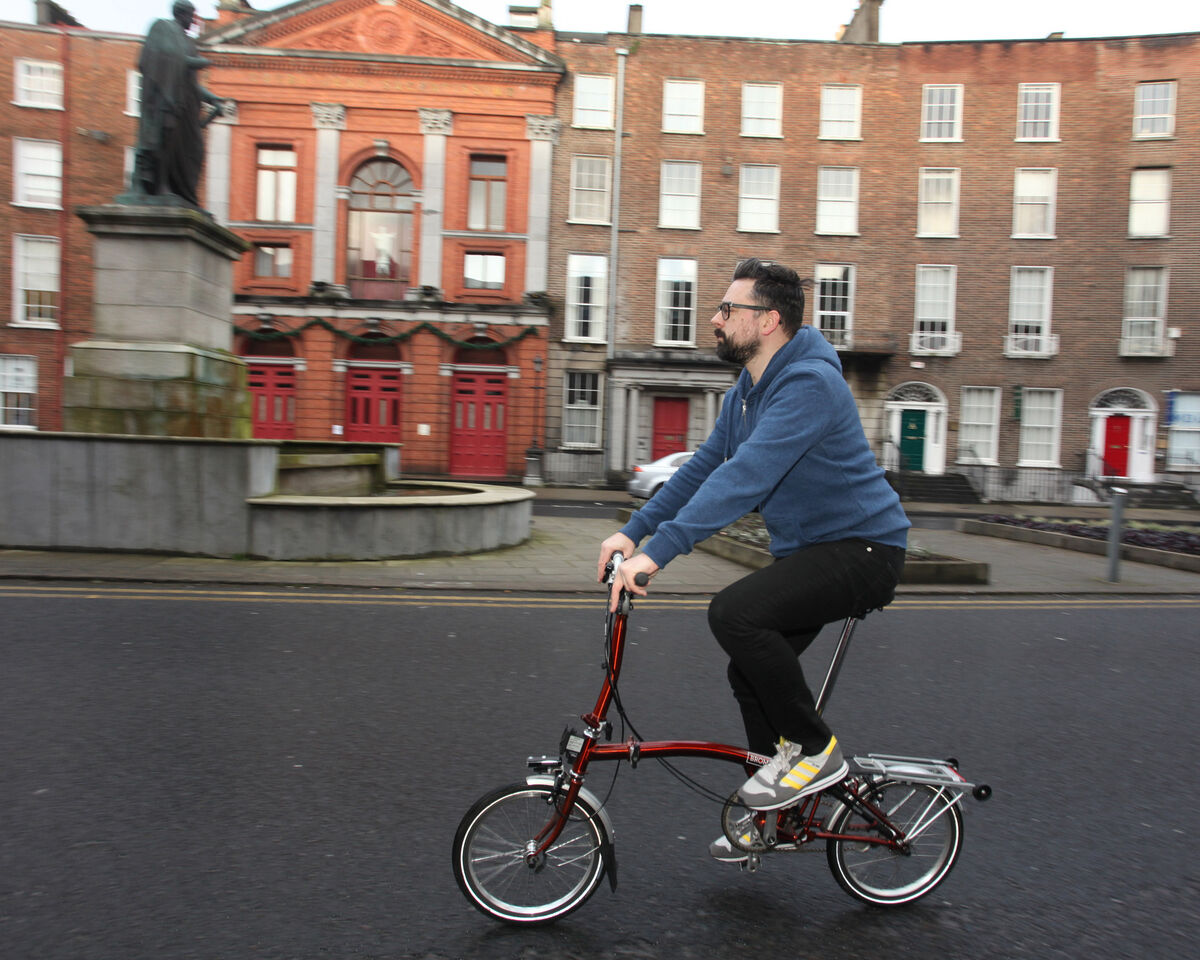
Mr Tobin said that another key focus should be on having enough safe and secure places for people to park their bikes.
“We do have an issue in Limerick with bike theft, which is a deterrent that pushes people away from cycling. The rate of theft in Limerick is significantly higher than the vast majority of other cities, with the exception of Dublin,” he said.
“Limerick is significantly under-served for bike parking. We only have 207 stands in Limerick City. Cork, the second biggest city, is at 1,350, Limerick as the third biggest city is at 207, and Galway as the fourth biggest city is at 517. So there's a big disparity there. It’s going to have to be included in the cycle network plan as to how they ensure that the parking is of good quality and in the right places to ensure people are encouraged to cycle,” he added.
Meanwhile, the proportion of commuters driving rose dramatically, as 58.4% of people drove to work, 1.4% of teenagers driving themselves to secondary school (a fourteen-fold increase), and 23.4% of students driving themselves to college (a complete reversal of the 1986 picture).
What’s striking about the figures is the difference between Dublin and the rest of the country — in 2016, two-thirds of all those who cycled to work in the country were in Dublin city and suburbs, while in rural areas and all towns with less than 10,000 persons, less than 1% of the commuting population cycled to work.
In 2019, a National Travel Survey found that over two-thirds of one-person journeys (67.6%) were by private car. The survey also asked adults how often they took journeys by bicycle - 85% of people never do.
This is despite overwhelming evidence that cycling is good for individual health and wealth, as well as delivering numerous benefits for society and the economy as a whole.
While Cork city’s cycling facilities are improving, albeit slowly, Mary Sinnott of Waterford BUG (Bicycle Users Group) says the opposite is the case in Waterford.
Waterford City first introduced cycling-specific infrastructure 15 years ago, with a network of greenways, off-road and on-road cycle lanes which now extends to approximately 58 km of cycle lanes within the City area.
Waterford is no different than many other cities with a dominant reliance on the car for access to the city centre, to schools, work, retail and other journeys. The modal share of cycle commuting to school and work in the city area is less than 5%.

The completion of the Waterford to Dungarvan Greenway in 2017 transformed cycling in the county, by creating a 46km off road cycle and walking trail built on the line of the former Waterford City to Dungarvan railway line. The Greenway has been hugely influential in changing the perception of cycling in Waterford, with over 250,000 unique trips currently made on the Greenway annually.
The final 2km of the Greenway linking Bilberry to Waterford City centre is due to be completed later in 2022, and a new sustainable transport bridge across the River Suir will commence construction in 2022 linking the Greenway with the Ferrybank, the North Quays and the new Waterford – New Ross greenway which is currently under construction.
However, while Ms Sinnott agreed that the Greenway is a great asset to Waterford, what’s needed is a focus on infrastructure for commuters rather than just leisure cyclists, she said.
“Off the Greenway, it’s not safe enough, and certainly for children, you would really need to think many times before you would send your child to the shop or to school on the bike,” she added.
A 2014 Cycle Network Plan described the existing network as “fragmented”, not quite providing integrated seamless linkages between the major trip origins and destinations.
However, it said that the existing cycling infrastructure elements “form a good base for what can potentially become a comprehensive network”.

Ms Sinnott said not much has changed in the city in terms of cycling infrastructure since she was growing up.
“I’m from Waterford, I grew up here, and really the infrastructure hasn't changed much at all. I don't see it has significantly improved in the 40 years that I've been cycling,” she said.
“The big thing is that there's a lack of a network, there's nothing continuous and there's no real dedicated place for cyclists on very popular or heavy routes for example to the hospital, or to the industrial estate, or WIT. Waterford City and County Council have a proposed cycling network plan which is a number of years old, and I suppose it came down to funds that it wasn't implemented,” she said.
“At the start we don’t need fabulous infrastructure, it's really just to have a safe space for cyclists and to make sure that there are lanes that are continuous, that link work and study, that can be used by young and old alike,” she added.
The National Transport Authority has allocated €14m to Waterford Council in 2021, to develop a programme for the construction of a new 50km network of separated cycleways connecting the WIT/TUSE campus on the Cork Road, the city centre, cross-city routes, and suburban areas.
The public bike hire scheme is currently being introduced into Waterford City and the provision of a network of 14 docking stations (with an average of 1- 12 bicycles at each) is expected to be up and running early this year.
The Netherlands Institute for Transport has found that riding a bicycle to work every day reduces the risk of premature death by 41%, halves the risk of dying from heart disease, and reduces the risk of dying from cancer by 40%. Regular cycling boosts physical fitness and compares to one to two weekly gym sessions, with the largest benefits to be expected among people who currently get little exercise.
The European Cycling Federation, meanwhile, states that engaging in moderate physical activity reduces the risk for Alzheimer’s disease by 29% and for cognitive decline by about 26%.
Apart from that, cycling makes you feel good. People who walk or cycle to work tend to be more satisfied, less stressed, more relaxed, and experience greater freedom compared to people who drive their car to work. Two-thirds of Dutch residents aged 18 and over associate cycling with joy.
As for its impact on a commuter’s pocket, the Netherlands Institute for Transport estimates that the annual costs of cycling range from €175 to €300. By comparison, the AA has estimated that the average cost of running a family car for a year in Ireland is over €10,600.
On a wider scale, the environmental benefits of getting more people on the saddle are no secret. Each 7 km by bicycle rather than by car will save an emission of 1 kilogram of CO2, 1.5 g of nitrogen oxides and 7 mg of particulate matter. Cycling already saves emissions equaling more than 16 million tons of CO2 equivalents per year in the EU — equal to the total yearly CO2 emissions of Croatia. Cycling also saves more than 3 billion litres of fuel per year, the equivalent of fuel consumption for road transport of all of Ireland.
In terms of resources, the average bike is about 1.5% of the weight of a car. Some manufacturing materials are the same, but used in much less quantities (e.g. steel, aluminium, different polymers), and others, like platinum or palladium for catalytic converters which cause significant emissions and environmental damage during their extraction, are not used at all for the manufacturing of bicycles.
As bikes take up less space and are cheaper than cars, so too is the infrastructure they need. A moving car takes up 28 times more space than a moving bicycle, while a parked car takes up 10 times more space than a parked bicycle. Annual infrastructure costs per traveller kilometre are €0.03 for bicycles, €0.10 for cars, €0.14 for buses, and €0.18 for trains.
As evidenced by census figures, the number of children cycling to school every day has dropped in parallel with the increase of cars on the road. For parents that still do cycle the school run, safety is a huge concern.
In Limerick, a school cycle bus has been operating for three years, where students cycle together to school, carefully marshalled by parents. Parent Anne Cronin said while there are many benefits to cycling together as a group, it’s a symptom of a dangerous cycling environment, rather than a solution to it.
“It is fantastic in terms of promoting cycling, children cycling, and encouraging other people to do the same, but then the cynic in me thinks, in an ideal scenario, you would need these types of things. But nevertheless, we keep at it,” she said.

Thorsten Ohlow lives in Cork city with his family. Having moved to Ireland from Germany, where cycling is much more mainstream, Mr Ohlow says he is “nearly made out to be a rebel” for cycling around the Rebel city, especially on the school run with his 11-year-old, and nine-year-old twins.
“The RSA still go on about things like high vis vests, and put all the pressure on the kids and the cyclists to be safe - yes the cycling infrastructure is important but I really feel it's the education part that needs to improve actually, for people to be more aware that your car can kill people, and it's not benign to do things like jump a red light if it’s only changed two seconds ago, and that kind of thing,” he said.
Orla Burke also lives in Cork city centre. A history of epilepsy means she has never had access to driving, and she cycles her two children to créche and school in her Cargo bike.
She says that the odd “dodgy driver” is outweighed by the benefits of cycling the school run.
“Sometimes you do come up against dodgy drivers out there, but I tell you, I don't think anybody besides people walking or cycling arrive back from the school run with a smile on their face. That thing of the endorphins from having exercised and moved your body. You don't really get that in a car, It's not the same,” she said.
Ms Burke says certain features of cycling infrastructure don’t accommodate her larger-than-usual cargo bike, and pose similar issues for those with disabilities who may be riding non-standard vehicles.
“One of my big issues around the city is kissing gates. There are cycle lanes in Cork City I can't use because they have these kissing gates that are supposed to stop antisocial behavior, but what they just do is they stop people on non-traditional bikes accessing spaces,” she said.
“People think, ‘oh, you can just get off and push your bike through’. Some people can, if the bike is small enough. But if you are a wheelchair user, how are you supposed to get off your hand cycle? I understand the kissing gates are there to stop antisocial behavior, but I think it's really antisocial to exclude disabled people using spaces,” she added.
The Cycle to Work Scheme is a tax incentive scheme to encourage employees to cycle to work. Under the scheme, an employer can pay for a new bicycle (including bicycle accessories) and the employee then repays the cost in regular instalments from their gross salary. The employee is not liable for tax, PRSI or the Universal Social Charge (USC) on their repayments. This means that someone who is on the highest rate of tax will save around 50% on the cost of the equipment.
The scheme was introduced in 2009 as an incentive to support cycling as a mode for commuting to work.
Chryssa Dislis is part of the sustainability team in Johnson Controls, headquartered in Cork city. She says a lot of her colleagues avail of the Bike to Work Scheme, especially because her employer goes to great lengths to promote it.
“Our bike to work scheme is very easily accessible, it's on our intranet, we have a person who is there to give advice, and a lot of people have availed of the scheme. We did a whole session about if you wanted to start cycling to work, aimed at new cyclists. We had fantastic input from the Cork Cycling Campaign, and the Bike to work team came in to explain how to go about it,” she said.
She said that pre-pandemic, there was a strong culture of cycling to work, with up to 50 bikes parked up at the office building that housed about 1,000 people. That’s a 5% modal share, five times the Cork city average.
Ms Dislis also said that having the proper facilities for cyclists makes it far more attractive for employees.
“There’s at least 100 bike parking racks in the underground car park, which is probably more in terms of spaces because you can have more than one bike per rack. There's also a repair station, for if you have a flat tire or you want to adjust your brakes, it’s all there,” she said.
Ms Dislis said that in addition to showers and changing facilities, there is also a ventilated room to dry clothes, which she says is an easy addition for employers to make that could be even more useful than showers for city commuters.
“Even just having a small room with a bit of ventilation where people can dry clothes makes a huge difference, more than having showers, I think. Other people might think showers are very important, and for longer distances it's a different story, but most people I know who cycle city distances by bike would not be hopping in the shower, they would cycle in their work clothes and they would take the raincoat off and then go to work. So having somewhere to dry clothes is a big deal; you don't want to be dripping in work,” she said.
“After that, advertise the bike to work scheme, make it known, have an email at the beginning of the year saying, ‘Hey, new years resolution?’ People want to cycle, but they might worry about safety, so having some kind of cycling awareness training is really the icing on the cake,” she added.
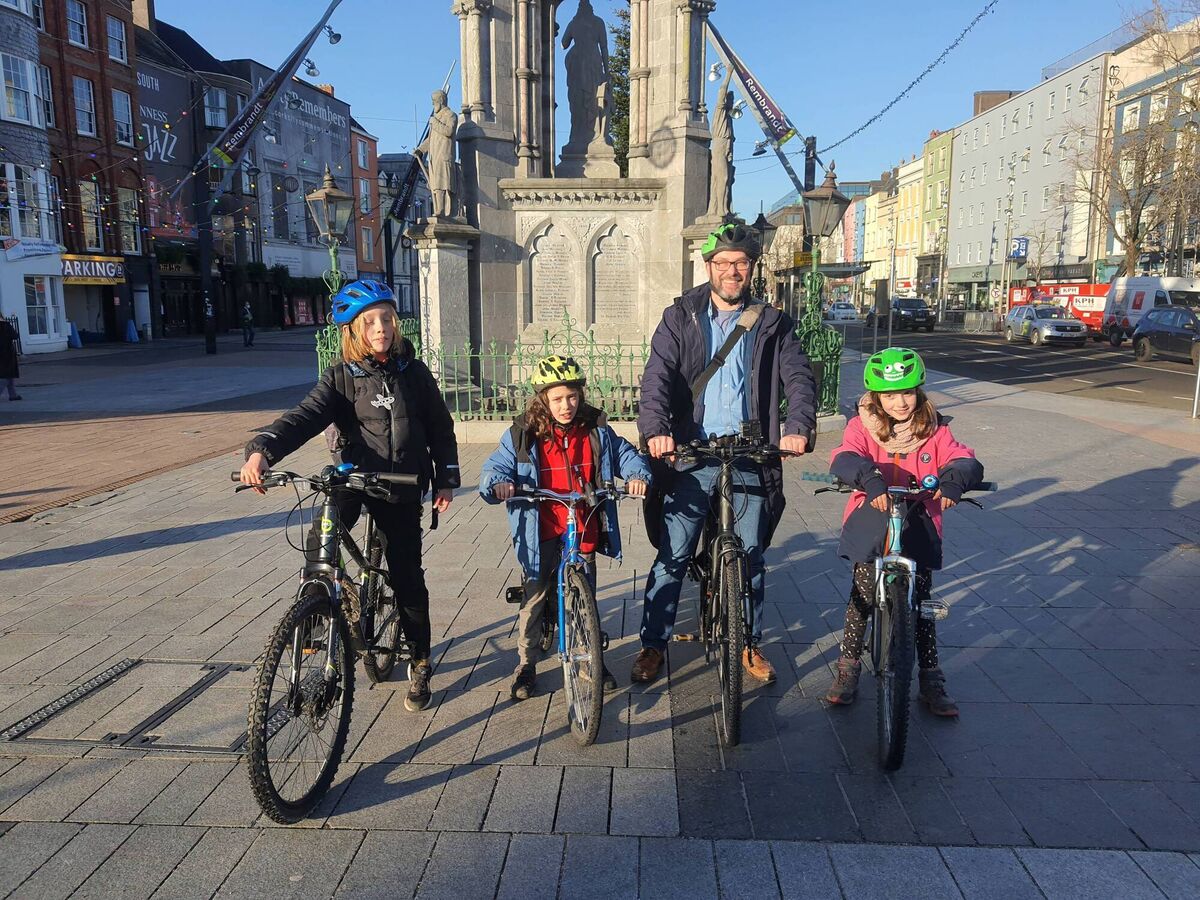
The Netherlands is the number one country in the world when it comes to cycling. A population of at least 17 million people are outnumbered by their 22.8 million bicycles, with a modal share of over 25% cycling, on a network of 35,000 kilometres of bicycle tracks.
While there has always been a strong cycling culture amongst the Dutch, a move away from planning which favoured the car only happened in the 1970s, when Dutch people took to the streets to protest against the high number of child deaths on the roads.
Here in Ireland, climate commitments have provided a clear mandate to get cars off the road, and the government's Climate Action Plan has committed to 500,000 additional daily walking, cycling and public transport journeys by 2030.
The pandemic has also propelled the development of cycling infrastructure not only in Ireland but all over the world.
The European Cyclists Federation has been tracking the progress of Covid-19 cycling infrastructure. Forty-three of the EU’s 94 biggest cities announced or implemented cycling measures during the Covid-19 pandemic. A total of €1.7bn was allocated for cycling promotion during the pandemic, with almost 1,500 kilometres of lanes implemented.
Ireland is fifth in the Federation’s leaderboard, having announced 12.47km of cycle lanes per million of population. The UK only announced 1.81km/million, while at the top of the table is Luxembourg, which announced 88.94 km of lanes for every million people.
Colm Ryder is Chairperson of Cyclist.ie, the national cycling advocacy network. He thinks that Ireland can turn around its car-crazed culture, and says there’s “no reason why we couldn’t” match the Netherlands in terms of cycling.
“It's been taking a long time to turn that back around again, but people are realising that we just can't keep going the way we're going in terms of cars, and congestion. Everybody won't be capable of cycling for various reasons. But cycling is part of the equation to take cars off the road,” he said.
“Cycling groups in Cork, Dublin, Limerick, wherever, will be pushing and shouting and keeping people on their toes. These things have to happen, and I think we can move, we just need to move faster. The next five years will be pretty critical,” he added.
As mentioned by Kerry Cycling Campaigner Anluan Dunne, the first major step is to change the number one concern of cyclists from ‘will I be killed by a car?’ to ‘will I get wet today?’ And if your main concern is getting wet while cycling, there’s a famous Dutch phrase: “Jij bent niet van suiker gemaakt”.
Which translates as “you’re not made of sugar”, and you won’t melt.
Economically, cycling produces global benefits of €150 billion per year for the environment, public health and the mobility system. In comparison, a recent study by the European Commission estimated the costs for the environment, health and mobility of motorised road transport at €800 billion per year.
Plus, cyclists spend. In France, cycle tourists spend almost 20% more than the average for all tourists. Per square metre, cycle parking delivers 5 times higher retail spend than the same area of car parking. Cyclists do their shopping locally, and are more loyal customers.
So why don’t people cycle?
In the 2019 National Travel Survey, respondents said the #1 thing that would get them to cycle more was safer cycling routes.
An average of 10 cyclists per year have been killed on Irish roads since 2014. While this number has been dropping more recently, to 7 deaths in 2021, the number of cyclists being injured annually is steadily increasing, from 630 in 2012 to 1,129 in 2019, for the first time overtaking the number of injured pedestrians, which was 1,084 in 2019.
Anluan Dunne is a member of Kerry Cycling Campaign, and said that particularly in more rural areas, safe cycling infrastructure is “non-existent”.
“If you had safe routes, like a segregated lane with proper protection for the cyclists that really created that sense of safety, then millions more people would cycle, I mean, the amount of journeys within our potential is huge,” he said.
“To really get the masses embracing it, you need to give them the space and a real sense of safety. So if they get on a bike, their first thought goes from being ‘will I be killed by a car?’ to ‘will I get wet today, should I put on an extra jacket or a pair of rain trousers?’. If we can do that, I really think you will see more people cycling,” he added.
Across Munster’s three largest cities, cycling infrastructure has been delivered with varying degrees of usability for those who, like the respondents to the 2019 National Travel Survey, are looking for a safe space to cycle.










